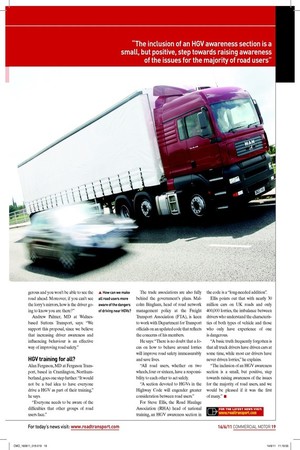Road to recognition
Page 16

Page 17

If you've noticed an error in this article please click here to report it so we can fix it.
The government has finally announced plans to include a chapter on HGV awareness in the Highway Code – but is it too little, too late?
Words: Roger Brown
LAST MONTH the government announced plans to include an HGV awareness chapter in future editions of the Highway Code. Although the exact timing of this has not been conirmed, the move has received widespread praise from inside the haulage industry.
According to Craig Leslie, MD at Glasgow-based Gordon Leslie Group, the news is “good and long overdue” .
He says: “Clearly the movements and characteristics of an HGV are completely different from that of a car. When learning to drive, people should be aware of how large vehicles behave while on the open road, and be able to react accordingly.” John Probert, chairman of Wyvern Cargo, based in Poole, Dorset, also describes the initiative as “very much overdue” .
He explains: “It should focus on creating awareness of the special situations connected with such vehicles.
“For example, HGVs take up more than one lane when changing direction on roundabouts and road intersections. Give them the space they need and beware of their blind spots.” In January 2010, the sometimes uneasy relationship between car and HGV was brought sharply into focus when a Renault Clio became trapped at the front of one of Arclid Transport’s tanker trucks on the A1(M) motorway in West Yorkshire. A video taken of the incident – which later became a hit on YouTube – showed the Cheshire-based haulier’s vehicle appearing to push the car, with its driver inside, along the road.
At a later driver-conduct hearing, North West Area TC Beverley Bell described the motorist’s attempted undertaking manoeuvre as “ill-advised” and completely exonerated the company, as well as its driver John Tomlinson.
Peter Larner, MD at Suckling Transport, based in Thurrock, Essex, believes it is “essential” that truck advice and awareness is provided in the code. “It is important that other road users understand the problems of visibility for HGV drivers when turning left,” he explains.
In CM’s Trucking Britain Out of Recession survey published in February last year, almost a ifth (18%) of respondents said they wanted to see changes to the code that would mean motorists, motorcyclists and cyclists made more aware of HGVs.
This was more than the percentage of people wanting the government to tackle truck crime, review pre-pack administration legislation or inish the study into the viability of operating longer semi-trailers on UK roads.
Ensuring safety
One haulier who describes the plans as “really proactive” and “very positive” is David Grocott, joint MD at Grocontinental, based in Shropshire.
“Given the prevalence of HGVs in this country, it is imperative that relevant safety information is available to all road users.
“As operators we are rightly heavily regulated to ensure safety on the roads, and we have recently renewed our leet of vehicles, which includes a host of safety features that are ultimately designed to protect other road users.
“The inclusion of the HGV awareness section in the Highway Code will provide the missing link to get important information to all road users,” he says.
Probert believes all motorists need to be aware that the stopping distance for a 44-tonne truck is longer than for the average car.
“For motorists, don’t cut into the gap between a lorry and the vehicle ahead of it and respect the stopping distance of lorries which approach you,” he says.
“Tailgating lorries is especially dan gerous and you won’t be able to see the road ahead. Moreover, if you can’t see the lorry’s mirrors, how is the driver going to know you are there?” Andrew Palmer, MD at Widnesbased Suttons Transport, says: “We support this proposal, since we believe that increasing driver awareness and inluencing behaviour is an effective way of improving road safety.”
HGV training for all?
Alan Ferguson, MD at Ferguson Transport, based in Cramlington, Northumberland, goes one step further. “It would not be a bad idea to have everyone drive a HGV as part of their training,” he says.
“Everyone needs to be aware of the dificulties that other groups of road users face.” The trade associations are also fully behind the government’s plans. Malcolm Bingham, head of road network management policy at the Freight Transport Association (FTA), is keen to work with Department for Transport oficials on an updated code that relects the concerns of his members.
He says: “There is no doubt that a focus on how to behave around lorries will improve road safety immeasurably and save lives.
“All road users, whether on two wheels, four or sixteen, have a responsibility to each other to act safely.
“A section devoted to HGVs in the Highway Code will engender greater consideration between road users.” For Steve Ellis, the Road Haulage Association (RHA) head of national training, an HGV awareness section in the code is a “long-needed addition” .
Ellis points out that with nearly 30 million cars on UK roads and only 400,000 lorries, the imbalance between drivers who understand the characteristics of both types of vehicle and those who only have experience of one is dangerous.
“A basic truth frequently forgotten is that all truck drivers have driven cars at some time, while most car drivers have never driven lorries,” he explains.
“The inclusion of an HGV awareness section is a small, but positive, step towards raising awareness of the issues for the majority of road users, and we would be pleased if it was the irst of many.” ■














































